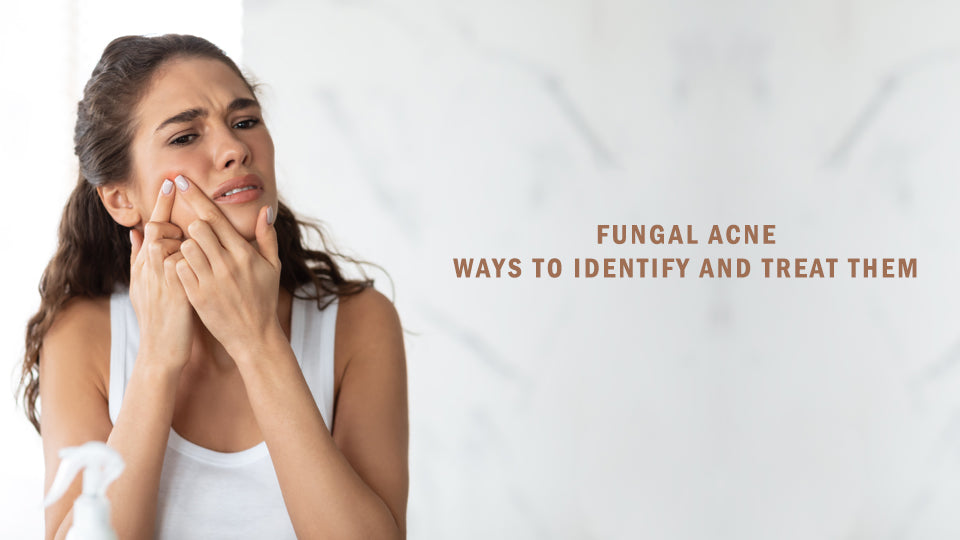Fungal Acne: Ways to Identify and Treat Them

Skin problems come in various forms, mainly acne, blemishes, hyperpigmentation, dullness, dark spots, etc. Among these, acne is a common one. But, not all bumps that appear on the skin are acne. Though these look more similar to regular acne, they can be different, like fungal acne. Do you want to know how fungal acne differs from regular acne and how to treat it? We’ve rounded up some of the best ways to identify fungal acne and the effective remedies to treat them. Scroll down;
What Is Fungal Acne?
Though it is often confused with acne, it isn’t the regular acne; instead, it’s known as pityrosporum folliculitis.
Fungal acne is a skin condition where the hair follicles are infected. The infections of the hair follicles on your face or body give rise to small raised bumps which look exactly like pimples. Here, the hair follicles get infected and inflamed, leading to pustules on the skin.
It appears in the form of small pimple breakouts, commonly seen on the cheeks, forehead, upper chest, and back. In most cases, it’s difficult to identify fungal acne, but once you succeed in diagnosing it, treating this skin condition is simple.
Fungal Acne: How to identify it?
As mentioned, identifying fungal acne is quite a difficult task. Still, there are specific ways to find out whether the bumps on your skin are fungal acne or not. Fungal acne is itchy when compared to acne vulgarism. Some of the symptoms that you’ll notice for fungal acne are;
- Small red bumps/papular acne.
- Swelling surrounding the skin
- Irritated hair follicles.
- Very itchy but not painful
- Doesn’t get better with normal acne treatments
Fungal Acne: What are its causes?
Unlike the other skin conditions, there are certain reasons behind your fungal acne. Some of them are listed below;
Sweat: Those clingy and sweaty clothes after a workout session or jogging is one of the reasons behind those red itchy bumps.
Through contacts: This skin condition may be contagious as it’s caused by a yeast infection, which is contagious. So, there are changes to spread the infection through bodily contact.
Excess heat or humidity: Yeast which causes fungal acne, increases more during excessive heat and sweat.
Intake of certain medications: the overuse or long-term use of oral or topical antibiotics can cause fungal acne.
Fungal Acne: How to Treat?
When it comes to fungal acne, treatments alone don’t work. Following a few changes in your hygiene and daily habits is a must. Moving on to the treatments options, you can find some effective home remedies, OTC antifungal treatments, and oral antifungal medicines;
Effective Home Remedies to Treat Fungal Acne:
Tea Tree oil:
It is rich in nutrients and is antiseptic and antifungal. This powerful oil is found best in treating fungal acne. One thing to keep in mind while using tea tree oil on the skin is to dilute it using carrier oil before applying it to the skin. Similarly, it’s wise to conduct a patch test before using it on the face or other body parts if you have a sensitive or extremely dry.
Honey
Honey, in its purest form, has numerous skin benefits and amazing healing properties. It contains hydrogen peroxide, an antiseptic that helps destroy bacteria and fungus. You may apply honey to the infected area to soothe and treat fungal acne.
OTC Antifungal Treatments
Luckily, various OTC antifungal ointments and creams are available to treat fungal acne. Butenafine and ketoconazole are some of the most commonly used products to treat fungal acne on the skin.
Oral Antifungal Medication
If you find that home remedies and OTC aren’t helping to control fungal acne or if the skin condition is worsening, it’s wise to consult your dermatologist at the earliest and start oral antifungal medications for a quick cure and to prevent the skin condition from worsening.
Fungal Acne: How to prevent them?
Though we have many options to treat this skin condition, the following few steps will help you prevent fungal acne breakouts;
Choose proper outfits: Avoid tight-fitting clothes and use loose clothing, preferably with natural fabrics, and do not stay longer in those clingy, sticky clothes after excessive sweating.
Shower as soon as you can: Shower after exercising or if you are sweating excessively.
Use anti-dandruff shampoo: This will help keep the scalp clean and balance yeast on your skin.
Follow a healthy diet: If you are somebody who consumes more sugary carbohydrates, it’s time to follow a balanced diet with more fruits and vegetables as fungi like yeast thrive more on sugary carbohydrates.
As fungal acne is entirely different from regular acne, so is its treatment. Never try anti-acne treatments to treat fungal acne; it won’t do any good; instead, it may worsen the skin condition. Proper treatment and following healthy habits can easily help treat this skin condition at the earliest.